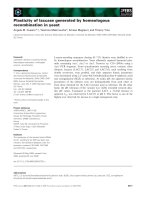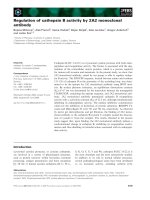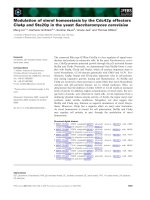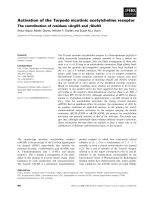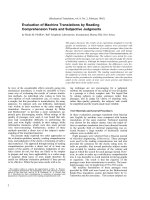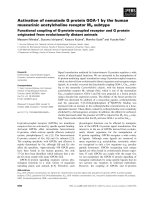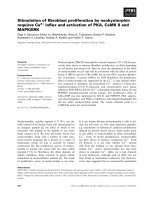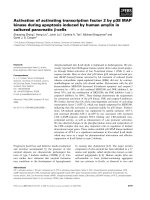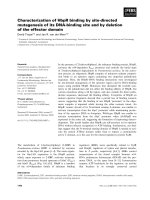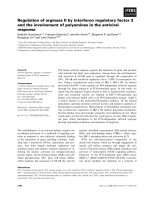Báo cáo khoa học: Activation of cathepsin D by glycosaminoglycans docx
Bạn đang xem bản rút gọn của tài liệu. Xem và tải ngay bản đầy đủ của tài liệu tại đây (316.13 KB, 10 trang )
Activation of cathepsin D by glycosaminoglycans
Marie Beckman
1,2
, Craig Freeman
3
, Christopher R. Parish
3
and David H. Small
4
1 Department of Biochemistry and Molecular Biology, Monash University, Clayton, Australia
2 Life Sciences, So
¨
derto
¨
rn University, Huddinge, Sweden
3 Division of Immunology and Genetics, The John Curtin School of Medical Research, The Australian National University, Canberra, Australia
4 Laboratory of Molecular Neurobiology, Menzies Research Institute, University of Tasmania, Hobart, Australia
Introduction
Cathepsin D (CD, EC 3.4.23.5) is a member of the
family of aspartic proteases. It is a major lysosomal
protease involved in protein degradation [1,2]. In addi-
tion, CD has a function in the activation or inactiva-
tion of a range of proteins, such as enzymes, hormones
and biologically active peptides. Interest in CD as a
drug target stems from its possible involvement in a
diverse range of pathological conditions, including
breast cancer and neurodegenerative diseases.
CD matures via a series of post-translational modifi-
cations [3]. It is synthesized as a preproenzyme of 412
amino acid residues. The signal peptide is removed
within the endoplasmatic reticulum and after transport
of the proenzyme to an acidic compartment, it is
activated by proteolytic removal of a 44 amino acid
residue prodomain. The mature form of CD may exist
in a single- or two-chain form, both of which are
equally active [4]. The two-chain form of human CD is
Keywords
aspartic protease; cathepsin D;
glycosaminoglycan; heparin; proteolytic
activity
Correspondence
M. Beckman, Life Sciences, So
¨
derto
¨
rn
University, SE-141 89 Huddinge, Sweden
Fax: +46 8 6084510
Tel: +46 8 6084731
E-mail:
(Received 1 April 2009, revised
8 September 2009, accepted 16 October
2009)
doi:10.1111/j.1742-4658.2009.07444.x
We have previously shown that heparin can increase the activity of the pro-
enzyme form of Alzheimer’s b-site amyloid precursor protein cleaving
enzyme 1 (BACE1). Cathepsin D (CD) is a member of the aspartic prote-
ase family and has sequence similarity to BACE1. Therefore, we examined
whether heparin and other glycosaminoglycans (GAGs) can influence the
activity of CD. Heparin and other GAGs were found to stimulate the
activity of recombinant proCD. Desulfation of heparin almost abolished
the stimulation, indicating that sulfate groups were important for the stim-
ulatory effect. In addition, the stimulation was dependent on the length of
the GAG chain, as larger GAGs were more potent in their ability to stimu-
late proCD than shorter fragments. In the presence of heparin, limited
autocatalytic proteolysis of the proenzyme was increased, suggesting that
heparin increases the activity of proCD by accelerating the conversion of
proCD, which has little activity, to pseudoCD, an active form lacking resi-
dues 1–26 of the prodomain. Furthermore, the activity of spleen-derived
mature CD, which lacks the entire 44 amino acid residue prodomain, was
also increased by heparin, indicating that the catalytic domain of CD con-
tains at least one region to which GAGs bind and stimulate enzyme activ-
ity. Because heparin also stimulated the activity of pseudoCD, proenzyme
activation was probably accelerated by the interaction of heparin with the
catalytic domain of pseudoCD. However, it is possible that heparin may
also activate the proenzyme directly. On the basis of this study, we propose
that GAGs may regulate CD activity in vivo.
Abbreviations
BACE1, b-site amyloid precursor protein cleaving enzyme 1; CD, cathepsin D; CSE, chondroitin sulfate E; F, relative fluorescence; GAG,
glycosaminoglycan; HS, heparan sulfate; LH, lung heparin; MH, mucosal heparin; SEM, standard error of the mean.
FEBS Journal 276 (2009) 7343–7352 ª 2009 The Authors Journal compilation ª 2009 FEBS 7343
formed by excision of seven amino acid residues from
the N-terminal domain, resulting in the noncovalent
association of a C-terminal 34 kDa heavy chain and
an N-terminal 14 kDa light chain. In addition, CD
contains phosphorylated N-linked oligosaccharides
involved in targeting of the enzyme to lysosomes via
mannose-6-phosphate receptors [3].
ProCD is overexpressed and secreted at high levels
in many cancer-derived cell lines and has been shown
to have mitogenic effects on cancer cells, fibroblasts
and keratinocytes that are independent of the catalytic
activity of the enzyme [1,2,5,6]. Thus, proCD may
have a function apart from its role as the precursor of
lysosomal CD. Recently, proCD was also shown to be
secreted by activated microglia and the proenzyme has
been proposed to have a role in inflammation-
mediated neurodegeneration [7]. CD has also been
implicated in the pathogenesis of neurodegenerative
diseases such as Alzheimer’s disease, in which defects
in the endosomal–lysosomal system are observed in the
brain, including an upregulation of CD mRNA and
protein [8,9]. Very recently, CD has attracted attention
as a potential target for decreasing the concentration
of a-synuclein in Parkinson’s disease and other
synucleinopathies [10–12].
We have found that the glycosaminoglycan (GAG)
heparin can increase the activity of the proenzyme
form of the aspartic protease BACE1, i.e. b-site amy-
loid precursor protein cleaving enzyme 1 [13]. BACE1
is a membrane-anchored enzyme that catalyses the first
step in the production of b-amyloid, the protein that
accumulates in the brain of Alzheimer’s disease
patients [14]. For this reason, BACE1 is a major target
for Alzheimer’s disease drug development. We found
that proBACE1 can be activated by low concentra-
tions of heparin, a highly sulfated analogue of heparan
sulfate (HS), supporting the view that GAGs may play
an important role in the regulation of BACE1 activity
in vivo [13]. Our results suggested that the activation of
proBACE1 required the presence of the prodomain.
A preparation of BACE1 lacking the prodomain was
not stimulated by heparin. We also found that a pep-
tide homologous to the BACE1 prodomain bound
heparin, supporting the hypothesis that proBACE1
was activated via binding of heparin to the prodo-
main.
Commonly, heparin-binding sites correspond to sur-
face-exposed shallow pockets of positive charge con-
taining certain patterns of primarily basic and
hydrophobic residues [15,16]. Basic residues that are
more distant in sequence can also be important as
they may be brought spatially close through the fold-
ing of the protein. Alignment of the amino acid
sequences of the prodomains of BACE1 and CD
shows that an N-terminal pattern of basic and hydro-
phobic residues (I ⁄ V)R(L ⁄ I)PL(R ⁄ H) is conserved.
Following this motif, the N-terminal region (residues
1–14) contains three additional basic residues. As
there is also experimental evidence suggesting that
heparin can bind to the CD prodomain [17], we
hypothesized that proCD might also be activated by
GAGs.
GAGs are generally covalently linked to a protein
core to form proteoglycans [16]. Proteoglycans are
abundantly expressed at cell surfaces and in the extra-
cellular matrix to regulate a wide range of cellular pro-
cesses, including cell proliferation, differentiation and
migration. HS is a common GAG that is composed of
alternating units of uronic acids and glucosamine resi-
dues, which can be substituted with sulfate groups in
various positions. Heparin is a highly sulfated form of
HS. The sulfated saccharide domains on GAGs are
important in providing docking sites for protein
ligands, such as growth factors, extracellular matrix
proteins and enzymes [15,16]. Importantly, because
proCD may encounter GAGs extracellularly, on the
cell surface or intracellularly during trafficking through
the Golgi apparatus and the endosomal–lysosomal sys-
tem [1,3,18,19], it is feasible that GAGs may regulate
proCD activity during physiological or pathophysio-
logical conditions.
The aim of this study was to examine the effect of
heparin on the activity of proCD and mature CD. We
report here for the first time that both proCD and the
mature enzyme are activated by low concentrations of
GAGs in vitro, indicating a high-affinity interaction
between CD and GAGs that may be of importance
in vivo.
Results
Effect of GAGs on proCD activity
We have previously shown that proBACE1 can be acti-
vated by a low concentration of heparin (1 lgÆmL
)1
)
[13]. Therefore, to investigate the effect of heparin on
CD, the ability of recombinant human proCD to cleave
a peptide substrate was first examined in the absence or
presence of 1 lgÆmL
)1
porcine mucosal heparin (MH)
or the more highly sulfated bovine lung heparin (LH)
(Fig. 1A). In the absence of heparin, little activity was
observed over the first 40 min of incubation. This initial
lag phase has previously been shown to be the period
when the essentially inactive zymogen is converted to a
fully active form called pseudoCD [20,21]. Thereafter,
substrate peptide cleavage increased to 0.6 ± 0.01
GAGs activate cathepsin D M. Beckman et al.
7344 FEBS Journal 276 (2009) 7343–7352 ª 2009 The Authors Journal compilation ª 2009 FEBS
DFÆmin
)1
[mean ± standard error of the mean (SEM),
where F = relative fluorescence]. The addition of hepa-
rin significantly decreased the duration of the lag phase
by 15 min (MH) or 20 min (LH). In addition, the activ-
ity following the lag phase was substantially increased in
the presence of both types of heparin (2.6- and 3.4-fold
for MH and LH, respectively). Similar results were
obtained with an alternative substrate peptide for CD
(Fig. S1).
As sulfate groups on heparin are known to be
important for GAG binding properties, we examined
the effect of desulfated MH on enzyme activity. Des-
ulfated MH had no significant effect on the activity of
recombinant human proCD (Fig. 1A), showing that
the ability of heparin to stimulate enzyme activity was
dependent on sulfation of the heparin.
To investigate the role of negative charge density and
backbone structure further, we compared the effect of
bovine kidney HS, which is composed of the same disac-
charide units as heparin, but exhibits a lower overall
degree of sulfation than heparin (on average approxi-
mately < 1 versus 2.7 sulfate groups per disaccharide
unit) [15], and chondroitin sulfate E (CSE), which is
composed of disaccharide units containing glucuronic
acid and N-acetylgalactosamine with approximately 1.5
sulfate groups per disaccharide [22]. Compared with
heparin, we found that HS and CSE had an equal (CSE)
or slightly higher (HS) tendency to stimulate the activity
of the recombinant proCD (Fig. 1B). This indicated that
the difference in carbohydrate backbone structure
between heparin (or HS) and CSE was not critical for
the stimulatory effect of these GAGs. Furthermore, a
high degree of sulfation in heparin was not essential, as
HS, with its lower degree of sulfation, was at least as
potent as heparin in increasing enzyme activity.
Heparin can carry sulfate groups on the 2O-position
of the uronic acid residues or on the 6O-, N- and ⁄ or
3O-positions of glucosamine residues [15]. CSE from
Fig. 1. Effect of GAGs on enzyme activity of
recombinant proCD. Enzyme activity was
monitored by the increase in F during hydroly-
sis of 10 l
M substrate peptide in the
presence of: (A) 0 lgÆmL
)1
,1lgÆmL
)1
MH,
1 lgÆmL
)1
LH and 1 lgÆmL
)1
desulfated MH.
Data from all incubations are expressed as
means ± SEM, n = 3. Enzyme activity in the
presence of MH or LH was significantly
different from controls lacking heparin
(P < 0.0001, Student’s t-test). (B, C) Enzyme
velocity in the presence of 1 lgÆmL
)1
GAG
expressed as a percentage of the velocity in
the presence of 1 lgÆmL
)1
MH. Data from all
incubations are expressed as means ± SEM,
n = 3. Control, no GAG; deS, desulfated MH;
de2 ⁄ 3S, de-2 ⁄ 3O-sulfated MH; de2 ⁄ 3S ⁄
deNS, de-2 ⁄ 3O- ⁄ de-N-sulfated re-N-
acetylated MH; de6S, de-6O-sulfated MH;
CR, carboxyl reduced MH.
M. Beckman et al. GAGs activate cathepsin D
FEBS Journal 276 (2009) 7343–7352 ª 2009 The Authors Journal compilation ª 2009 FEBS 7345
squid cartilage is predominately sulfated at the 4O-
and 6O-positions of N-acetylgalactosamine [22]. To
gain further insight into the role of sulfation in specific
positions and the role of negative charge in general for
the effect of heparin on recombinant human proCD,
the effect of four chemically modified derivatives of
heparin: de-2 ⁄ 3O-sulfated, de-2 ⁄ 3O- ⁄ de-N-sulfated re-
N-acetylated, de-6O-sulfated or carboxyl reduced MH
was examined. The differentially desulfated forms of
heparin and the carboxyl reduced heparin all retained
their ability to stimulate the CD zymogen (Fig. 1B, C),
showing that the presence of the carboxyl group was
not critical for the stimulatory effect. Because total
desulfation of heparin almost abolished the ability of
MH to stimulate enzyme activity (Fig. 1A), the results
indicated that the effect was dependent on sulfation,
but that the specific position of the sulfate group in
the heparin molecule appeared to be less important.
Effect of heparin on autocatalytic cleavage of
proCD
The activation of proCD at acidic pH in vitro involves
the autocatalytic removal of residues 1–26 of the
prodomain [20,21,23]. The resulting enzyme, referred
to as pseudoCD, is a fully catalytically active form
retaining 18 residues (27–44) of the prodomain. As
heparin decreased the duration of the lag phase of
activity (Fig. 1), this suggested that the GAG may
stimulate the rate of autocatalytic cleavage of the
zymogen to pseudoCD. To investigate this possibility,
we incubated recombinant human proCD in the
absence or presence of heparin at pH 4. Aliquots taken
at different time points were then analysed on silver-
stained SDS ⁄ PAGE. Unincubated recombinant proCD
migrated as a doublet on the gel with an apparent
molecular mass of 46–50 kDa (Fig. 2A). This doublet
probably comprised two forms of proCD with differ-
ent degrees of glycosylation, as sequence analysis as
reported by the manufacturer indicated that the prepa-
ration contained only the single-chain proenzyme
form. After a 1 h incubation of the control, a protein
with an apparent molecular mass of 43 kDa, consistent
with the molecular mass of pseudoCD, was detected
and after 3 h of incubation the enzyme had mainly
been converted to the 43 kDa form. In the presence of
heparin, we found that most of the enzyme had
already been processed to a 43 kDa form within 1 h of
incubation. Because the detection of enzyme activity
requires a period of preincubation at acidic pH, and
because the activity increases in parallel with the
formation of pseudoCD, it has been concluded that
pseudoCD is the active enzyme species at low pH
in vitro and that the nonprocessed zymogen has little
or no catalytic activity [20,21]. Our result suggested
that heparin accelerated the conversion of proCD to
pseudoCD.
To determine whether residues 1–26 of the prodo-
main were required for the heparin-induced activation
of recombinant human proCD, we examined the effect
of MH on enzyme activity after the enzyme had been
converted to pseudoCD by preincubation for 24 h
(Fig. 2A). The addition of heparin to the preincubated
enzyme preparation activated the enzyme 4.5-fold
(Fig. 2B). Following preincubation, no lag phase was
observed, consistent with the view that activation of
the enzyme by cleavage of residues 1–26 had occurred
prior to the addition of MH. Because pseudoCD lacks
residues 1–26 of the prodomain, the result suggested
that other regions of the enzyme were required for
complete activation of proCD by heparin.
Effect of heparin on the activity of mature CD
The results suggested that residues 1–26 of the prodo-
main were not necessary for heparin-induced stimula-
tion of the enzyme. Therefore, we also examined
whether mature CD (lacking the entire prodomain)
could be activated by heparin. For this study, we used
a preparation of CD from human spleen. N-terminal
Fig. 2. Effect of MH on autocatalytic cleavage of recombinant
proCD and on the activity of the enzyme. (A) Silver-stained
SDS ⁄ PAGE showing the autocatalytic cleavage of proCD. Recombi-
nant proCD (2.5 lg in 100 lL, pH 4) was incubated in the absence
(control) or presence of 1 lgÆmL
)1
MH and aliquots of 20 lL were
analysed after 0–24 h incubations as indicated. *43 kDa form. (B)
The activity of recombinant human proCD that had been preincu-
bated for 24 h [8 lL of the reaction in (A)] was monitored in the
absence (control) or presence of 1 lgÆmL
)1
MH.
GAGs activate cathepsin D M. Beckman et al.
7346 FEBS Journal 276 (2009) 7343–7352 ª 2009 The Authors Journal compilation ª 2009 FEBS
sequence analysis of the enzyme was consistent with an
N-terminal domain beginning with the residues
GPIPE, as expected for the mature enzyme (data not
shown). Further analysis of the enzyme preparation on
silver-stained SDS ⁄ PAGE showed that spleen CD was
primarily in the two-chain form (Fig. 3A). Incubation
of the enzyme at acidic pH for up to 1 h in the
absence or presence of MH (1 lgÆmL
)1
) had no detect-
able effect on the apparent molecular mass of the
heavy and light chains, indicating that mature CD was
stable and not subject to autocatalysis under these con-
ditions. Next, the effect of MH on enzyme activity was
measured. Similar to the results with recombinant
proCD (Fig. 1B), 1 lgÆmL
)1
MH stimulated mature
spleen CD ( 7-fold) (Fig. 3B), whereas desulfated
MH had no effect on enzyme activity (data not
shown). Similarly to pseudoCD, no lag phase was
observed in the reaction with mature CD.
To determine whether the increase in activity was
due to an effect on the V
max
or K
M
of the enzyme
reaction, the ability of 1 lgÆmL
)1
MH to stimulate the
activity of mature spleen CD was measured over a
range of substrate concentrations (1–30 lm) (Fig. 3C).
The results showed that the V
max
of CD was increased
15-fold in the presence of MH (mean ± SEM:
1.5 ± 0.2 and 24.2 ± 2.7 DFÆmin
)1
in the absence or
presence of MH, respectively), whereas MH had no
effect on K
M
(mean ± SEM: 5.7 ± 2.4 and
7.3 ± 1.9 lm in the absence or presence of MH,
respectively). Taken together, the results showed that
similar to pseudoCD, mature CD can be stimulated by
low concentrations of MH. The observation that the
amount of activation of pseudoCD and two-chain CD
by MH was similar indicated that the effect of heparin
on pseudoCD was not dependent on the presence of
the remaining portion of the prodomain (residues
27–44). The finding that MH activated not only the
inactive zymogen, but also the mature enzyme indi-
cated that the enzyme has at least one binding site for
heparin outside the prodomain.
The role of polysaccharide chain length
We next investigated the role of polysaccharide chain
length on the amount of activation of recombinant
proCD. Because our previous results showed that
proCD and mature CD were markedly activated by
50 nm MH (1 lgÆmL
)1
of 17–19 kDa MH), we
examined the effect of 50 nm di-, tetra-, hexa- and
octasaccharides and longer (3–4 and 4–6 kDa) MH or
(15 and 22 kDa) HS moieties on enzyme activity. Of
the oligosaccharides tested, only the hexa- and
octasaccharides stimulated the activity of recombinant
proCD, with the octasaccharide being the most potent
(Fig. 4A, C). With increased chain length, the activity
increased from 1.6 ± 0.05 DFÆmin
)1
(mean ± SEM)
for 3–4 kDa to 3.8 ± 0.1 DFÆmin
)1
(mean ± SEM)
Fig. 3. Effect of MH on the activity of mature CD from human
spleen. (A) Silver-stained gel after SDS ⁄ PAGE. CD (2.5 lgin
100 lL, pH 4) was incubated in the absence (control) or presence
of 1 lgÆmL
)1
MH and aliquots of 20 lL were analysed after 0–1 h
incubations as indicated. For comparison, recombinant proCD
(r-proCD) incubated for 0 and 3 h is also shown from another part
of the same gel. The positions of proCD, the 43 kDa form (*),
heavy and light chains of CD are indicated. (B) F during CD hydroly-
sis of 10 l
M substrate peptide in the absence (control) or presence
of 1 lgÆmL
)1
MH. Data are expressed as means ± SEM, n =3.
(C) Velocity (DFÆmin
)1
) of product formation by CD as a function of
substrate concentration in the absence (control) or presence of
1 lgÆmL
)1
MH. Data for 1–30 lM substrate peptide are expressed
as means ± SEM, n = 2. The curves shown are calculated from a
best fit of the data to the Michaelis–Menten equation.
M. Beckman et al. GAGs activate cathepsin D
FEBS Journal 276 (2009) 7343–7352 ª 2009 The Authors Journal compilation ª 2009 FEBS 7347
for the 22 kDa derivative (Fig. 4B, C). In addition, the
lag phase decreased with increasing GAG size
(Fig. 4C, inset). Therefore, these experiments showed
that at a concentration of 50 nm, a hexasaccharide was
the smallest heparin-derived sugar that was able to
activate the CD zymogen. Furthermore, the potency of
the stimulatory effect of GAGs increased with polysac-
charide chain length. Of the GAGs tested, 22 kDa HS
resulted in the highest activation of proCD, indicating
that it was the most effective in accelerating the
conversion from proCD to pseudoCD.
Next we examined the effect of polysaccharide chain
length on the stimulation of the two-chain mature
spleen CD. Similar to recombinant proCD, we
observed that the activity of the two-chain enzyme was
stimulated by the hexa- and octasaccharides. There
was little effect of the di- and tetrasaccharides when
used at a concentration of 50 nm (Fig. 5A, B). Optimal
stimulation of the two-chain enzyme was achieved by
3–4 kDa MH and a further increase in chain length
did not increase the stimulatory effect. The result sug-
gested that 3–4 kDa MH, which corresponds to
Fig. 4. Effect of polysaccharide chain length on recombinant proCD
(r-proCD) activity. The figure shows the increase in F during r-proCD
hydrolysis of 10 l
M substrate peptide in the absence (control) or
presence of 50 n
M hexa- or octasaccharides (A) or in the presence
of a 50 n
M concentration of higher molecular mass GAGs: 3–4 kDa
heparin, 4–6 kDa heparin, 15 kDa HS or 22 kDa HS (B). Data from
all incubations are expressed as means ± SEM, n = 3. (C) Enzyme
velocity in the presence of 1 lgÆmL
)1
GAGs of different molecular
mass expressed as a percentage of the velocity in the presence of
1 lgÆmL
)1
MH. Data from all incubations are expressed as means ±
SEM, n = 3. The inset in (C) shows the duration of the lag phase as
a function of polysaccharide chain length.
Fig. 5. Effect of polysaccharide chain length on the activity of
mature CD from human spleen. The figure shows the increase in F
during CD hydrolysis of 10 l
M substrate peptide in the absence or
presence of 50 n
M octasaccharide, 3–4 kDa heparin, 22 kDa HS
(A). Data from all incubations are expressed as means ± SEM,
n = 3. The enzyme velocity in the presence of 1 lgÆmL
)1
GAGs of
different molecular mass expressed as a percentage of the velocity
in the presence of 1 lgÆmL
)1
MH is also shown (B). Data from all
incubations are expressed as means ± SEM, n =3.
GAGs activate cathepsin D M. Beckman et al.
7348 FEBS Journal 276 (2009) 7343–7352 ª 2009 The Authors Journal compilation ª 2009 FEBS
approximately six to eight disaccharide units per mole-
cule, was sufficient for optimal stimulation of mature
CD by GAGs under our experimental conditions.
Discussion
This study has demonstrated that GAGs can increase
the activity of CD in vitro. In this regard, our study has
shown that CD belongs to a group of enzymes includ-
ing BACE1, ADAM12, the cathepsins B, L and S that
are regulated by GAGs in vitro [13,24–27]. We found
that not only was the activity of the CD proenzyme
stimulated by GAGs, but the mature (prodomain-
cleaved) enzyme was also stimulated. In addition, we
found that heparin could increase the limited proteo-
lysis of proCD at acidic pH, concomitant with an
increased rate of substrate peptide cleavage. This
increased rate of autocatalytic activation may have
been due to direct stimulation of a small amount of
active enzyme in the preparation. We found that pseu-
doCD and the mature enzyme were stimulated by hepa-
rin to a similar degree, indicating that GAGs could
interact with the protease domain. The stimulation of
mature enzyme was due to an increase in enzyme V
max
.
It has been previously reported that the presence of
the C-terminal part of the propeptide in pseudoCD did
not significantly alter the basal enzymatic and struc-
tural properties of the enzyme as compared with the
mature two-chain form [23]. Therefore, our findings
suggest that activation of the zymogen is, at least in
part, caused by the binding of GAGs to newly formed
pseudoCD molecules. Their activation may in turn
accelerate the process of autocatalytic conversion of
proCD to pseudoCD, thereby accounting for the
GAG-induced decrease in the duration of the lag
phase. However, our data are also consistent with the
possibility that heparin can activate the zymogen
directly, as we have proposed for BACE1 [13]. Studies
of the binding of heparin oligosaccharides to well-
known heparin-binding proteins, including the protease
thrombin and fibroblast growth factor, have reported
binding affinities (K
D
) in the range of nm to low lm
[16]. The observation that low concentrations of hepa-
rin (50 nm) activated CD suggests that the interaction
between the enzyme and heparin is of high affinity.
However, the identity of the heparin-binding residues
in CD remains to be determined.
In comparison with the mature enzyme, which was
optimally stimulated by 3–4 kDa MH, activation of
the zymogen was more sensitive to the increasing poly-
saccharide chain lengths of HS up to 22 kDa. Activity
detected after incubation of proCD in the presence of
the 3–4 kDa MH derivative was < 50% of the activity
observed in the presence of 22 kDa HS. The higher
potency of the longer chains to activate the zymogen
might be explained by the fact that there are additional
residues within the prodomain that may contribute to
binding and that, as a consequence, the binding region
for the zymogen is larger than that of the mature
enzyme. Because the longer chains were not more
potent than the 3–4 kDa fragment in stimulating the
mature enzyme, our results are consistent with the
existence of an additional binding region in the prodo-
main. Support for the conclusion that the prodomain
contains a GAG-binding site comes from a recent
study on the capacity of prodomain peptides to inhibit
mature CD [17]. In that study, heparin decreased the
inhibitory effect of a peptide homologous to the N-ter-
minal part of the prodomain (residues 1–14) and the
effect was shown to be dependent on basic residues in
this peptide, thus suggesting that residues 1–14 of the
prodomain contain a binding site for GAGs.
In previous kinetic studies of the conversion of
proCD to pseudoCD, a two-phase mechanism has
been suggested [21]. In the initial phase, the first mole-
cules of pseudoCD are formed at a low rate and in the
following phase the process is autocatalytically acceler-
ated by newly formed pseudoCD molecules. It is possi-
ble that there is a mechanism by which the binding of
GAGs to the N-terminal part of the prodomain may
accelerate the reaction in the first rate-limiting step in
the activation of the zymogen, in which the conversion
of proCD to active pseudoCD is initiated. Because the
N-terminal part of the prodomain is inhibitory and
may retain an inhibitory capacity after its cleavage by
interacting with the active site [17], GAGs may also
act by sequestering the autocatalytically cleaved frag-
ment containing residues 1–26 away from the catalytic
cleft and thereby increase the rate of activation.
Whether GAGs directly increase the activity of proCD
by weakening the interaction between the prodomain
and the catalytic cleft, and ⁄ or render the prodomain
more accessible for cleavage, and ⁄ or play a role in the
sequestration of the cleaved 1–26 fragment remain to
be determined. In CD-deficient fibroblasts, the genera-
tion of pseudoCD by autoactivation is not required
for the intracellular maturation of CD expressed by
transfection or for the maturation of endocytosed
proCD [28]. However, in vivo, pseudoCD species are
formed by mechanisms involving cysteine proteases
and other unidentified proteases that cut at different
sites within the CD prodomain. Little is known about
the activation of secreted proCD, which may be
secreted both under pathological [1,7] and physio-
logical [29] conditions. ProCD and mature CD were
shown to be secreted by explants of various mouse
M. Beckman et al. GAGs activate cathepsin D
FEBS Journal 276 (2009) 7343–7352 ª 2009 The Authors Journal compilation ª 2009 FEBS 7349
tissues, such as kidney and heart under physiological
conditions [29]. It is noteworthy that the secreted CD
was found to be active, reportedly due to membrane
proton pumps generating a local acidification of the
environment [29]. Whether extracellular GAGs may
play a role in the activation of secreted CD remains to
be determined.
The interaction between enzyme and GAGs was
found to be dependent on sulfation of the GAG mole-
cule. HS, which has a relatively low overall degree of
sulfation, was as effective as the more extensively sul-
fated heparin and CSE in activating CD, indicating
that neither the difference in carbohydrate backbone
structure between MH ⁄ HS and CSE nor a higher
degree of overall sulfation was critical for the stimula-
tory effect. We also did not observe a requirement for
sulfation at specific positions in the carbohydrate
backbone. This finding suggests that the overall net
negative charge of the GAG may be more important
than the precise location of the sulfate groups.
The finding that CD can be stimulated by low con-
centrations of GAGs raises the possibility that GAGs
play a role in activating the enzyme in vivo. It is worth
noting that both CD and HS have for more than
20 years been implicated in cancer progression [1,2,30].
In view of the results of the present study, it might be
speculated that HS could be involved in the dysregula-
tion of CD that has been observed in various cancers.
In any case, an increased understanding of how GAGs
regulate the activity of CD may aid in the development
of drugs beneficial for pathological conditions in which
CD is involved.
Materials and methods
Materials
Recombinant human proCD, beginning at leucine 21 and
containing a C-terminal His-tag, was obtained from R&D
Systems (1014-AS, BioScientific, Gymea, Australia). CD
prepared from human spleen (catalogue number 219394)
and bovine LH (catalogue number 375093) were from Cal-
biochem (Merck, Kilsyth, Australia). Heparin from porcine
intestinal mucosa (MH, catalogue number H3393),
4–6 kDa porcine MH (H8537) and bovine kidney HS (cata-
logue number H7640) were obtained from Sigma-Aldrich
(Sydney, Australia). Porcine mucosal 15 kDa HS (HS1098)
was from Celsus Laboratories (Cincinnati, OH, USA), por-
cine mucosal 22 kDa HS (ORG553) was a generous gift
from Organon (Oss, The Netherlands) and squid cartilage
CSE (400678-1A) was from Seikagaku (Tokyo, Japan).
Heparin-derived di-, tetra-, hexa- and octasaccharides were
obtained from Dextra Laboratories (Reading, UK). The
substrate peptide I MCA-SEVNLDAEFRK(DNP)RR-NH
2
was purchased from MP Biomedicals (Seven Hills, NSW,
Australia), substrate peptide II MCA-PLGL-Dpa-AR-NH
2
from R&D Systems and microplates (OptiPlate-96 F) from
PerkinElmer Life Sciences (Boston, MA, USA). The Bio-
Rad Silver Stain kit was from Bio-Rad Laboratories
(Regents Park, Australia).
Preparation and chemical modification of heparin
derivatives
Totally desulfated heparin was prepared using the method
of Nagasawa et al. [31] by treatment of the pyridinium salt
form with dimethyl sulfoxide ⁄ water (9 : 1 by volume) for
2 h at 100 °C. 2 ⁄ 3O-desulfated heparin was prepared using
the method of Jaseja et al. [32] by dissolving heparin in
0.2 m NaOH and lyophilization. The N-desulfated deriva-
tive was prepared using the method of Inoue and Nagasa-
wa [33]. The pyridinium salt form was treated with
dimethyl sulfoxide ⁄ water (95 : 5 by volume) for 1.5 h at
50 °C. The N-desulfated compound was N-acetylated with
acetic anhydride using the method of Yates et al. [34].
Porcine MH was decarboxylated ( 80%) by treatment
with 1-ethyl-3-(3-dimethyl-aminopropyl)carbodiimide and
subsequent sodium borohydride reduction as described pre-
viously [35]. Heparin was chemically de-6O-sulfated using
the method of Toida et al. [36] using N, O-bis (trimethylsi-
lyl) acetamide. A 3–4 kDa heparin was prepared by free
radical degradation using the method of Volpi et al. [37].
CD activity assay
CD activity was measured using a quenched-fluorescence
assay with the substrate peptide I homologous to the
Swedish amyloid precursor protein mutant b-cleavage site
[38,39]. Previously, CD has been shown to cleave peptides
that encompass the EVNLDAEF sequence with a similar
catalytic efficacy as BACE1 [39–42]. Assays were performed
in a buffer of 0.1 m sodium acetate pH 4, 5% dimethylsulf-
oxide using 100 ng enzyme (unless otherwise specified) and
10 lm substrate peptide in a total volume of 100 lL in black
96-well plates. Heparin was dissolved in water and sterile fil-
tered with a 0.45 lm syringe filter. The increase in F pro-
duced by substrate hydrolysis was monitored at 37 °Cina
fluorescence microplate reader (FLUOstar, BMG Lab Tech-
nologies, Offenburg, Germany) or at room temperature
using a FLUOstar 403 (BMG Lab Technologies) with exci-
tation and emission wavelengths of 320 and 405 nm, respec-
tively. Background fluorescence (substrate incubated in the
absence of enzyme) was subtracted at each time point.
Enzyme activity was calculated from the change in F per
min (DFÆmin
)1
) during the linear phase of the reaction rep-
resenting the highest rate of cleavage. Graphs and statistical
calculations were made using graphpad prism software
(version 4.00, GraphPad Software Inc., La Jolla, CA, USA).
GAGs activate cathepsin D M. Beckman et al.
7350 FEBS Journal 276 (2009) 7343–7352 ª 2009 The Authors Journal compilation ª 2009 FEBS
Gel electrophoresis and western blotting
Samples ( 500 ng protein) were mixed with an equal vol-
ume of 2· SDS sample buffer and heated to 95 °C for
5 min prior to gel loading. The proteins were separated by
10% SDS ⁄ PAGE [43] and stained using Bio-Rad Silver
Stain reagent. An image of the signals obtained by silver
staining was acquired and relative molecular mass was
determined using an AlphaImager with alphaease software
(Quantum Scientific, Glebe, Australia).
Acknowledgements
We thank Professor A. Ian Smith and Ms Shane
Reeve, the Monash Biomedical Proteomics Facility,
Monash University for N-terminal sequencing. We
also thank Professor Einar Hallberg, So
¨
derto
¨
rn Uni-
versity, for generous support and use of his laboratory.
This work was supported by a project grant to DHS
and a programme grant to CRP from the National
Health and Medical Research Council of Australia.
References
1 Benes P, Vetvicka V & Fusek M (2008) Cathepsin D –
many functions of one aspartic protease. Crit Rev Oncol
Hematol 68, 12–28.
2 Liaudet-Coopman E, Beaujouin M, Derocq D, Garcia
M, Glondu-Lassis M, Laurent-Matha V, Prebois C,
Rochefort H & Vignon F (2006) Cathepsin D: newly
discovered functions of a long-standing aspartic prote-
ase in cancer and apoptosis. Cancer Lett 237, 167–179.
3 Zaidi N, Maurer A, Nieke S & Kalbacher H (2008)
Cathepsin D: a cellular roadmap. Biochem Biophys Res
Commun 376, 5–9.
4 Erickson AH (1989) Biosynthesis of lysosomal endopep-
tidases. J Cell Biochem 40, 31–41.
5 Glondu M, Coopman P, Laurent-Matha V, Garcia
M, Rochefort H & Liaudet-Coopman E (2001) A
mutated cathepsin-D devoid of its catalytic activity
stimulates the growth of cancer cells. Oncogene 20,
6920–6929.
6 Ohri SS, Vashishta A, Proctor M, Fusek M & Vetvicka
V (2008) The propeptide of cathepsin D increases pro-
liferation, invasion and metastasis of breast cancer cells.
Int J Oncol 32, 491–498.
7 Kim S, Ock J, Kim AK, Lee HW, Cho JY, Kim DR,
Park JY & Suk K (2007) Neurotoxicity of microglial
cathepsin D revealed by secretome analysis. J Neuro-
chem 103, 2640–2650.
8 Cataldo AM, Barnett JL, Berman SA, Li J, Quarless S,
Bursztajn S, Lippa C & Nixon RA (1995) Gene expres-
sion and cellular content of cathepsin D in Alzheimer’s
disease brain: evidence for early up-regulation of the
endosomal-lysosomal system. Neuron 14, 671–680.
9 Nixon RA, Mathews PM & Cataldo AM (2001) The
neuronal endosomal-lysosomal system in Alzheimer’s
disease. J Alzheimers Dis 3, 97–107.
10 Cullen V, Lindfors M, Ng J, Paetau A, Swinton E,
Kolodziej P, Boston H, Saftig P, Woulfe J, Feany MB
et al. (2009) Cathepsin D expression level affects alpha-
synuclein processing, aggregation, and toxicity
in vivo. Mol Brain 2,5.
11 Qiao L, Hamamichi S, Caldwell KA, Caldwell GA,
Yacoubian TA, Wilson S, Xie ZL, Speake LD, Parks
R, Crabtree D et al. (2008) Lysosomal enzyme cathep-
sin D protects against alpha-synuclein aggregation and
toxicity. Mol Brain 1, 17.
12 Sevlever D, Jiang P & Yen SH (2008) Cathepsin D is
the main lysosomal enzyme involved in the degradation
of alpha-synuclein and generation of its carboxy-termi-
nally truncated species. Biochemistry 47, 9678–9687.
13 Beckman M, Holsinger RM & Small DH (2006) Hepa-
rin activates beta-secretase (BACE1) of Alzheimer’s
disease and increases autocatalysis of the enzyme.
Biochemistry 45, 6703–6714.
14 Vassar R (2002) Beta-secretase (BACE) as a drug target
for Alzheimer’s disease. Adv Drug Deliv Rev 54 , 1589–
1602.
15 Hileman RE, Fromm JR, Weiler JM & Linhardt RJ
(1998) Glycosaminoglycan–protein interactions: defini-
tion of consensus sites in glycosaminoglycan binding
proteins. BioEssays 20, 156–167.
16 Gandhi NS & Mancera RL (2008) The structure of
glycosaminoglycans and their interactions with proteins.
Chem Biol Drug Des 72, 455–482.
17 Masa M, Maresova L, Vondrasek J, Horn M, Jezek J
& Mares M (2006) Cathepsin D propeptide: mechanism
and regulation of its interaction with the catalytic core.
Biochemistry 45, 15474–15482.
18 Egeberg M, Kjeken R, Kolset SO, Berg T & Prydz K
(2001) Internalization and stepwise degradation of hepa-
ran sulfate proteoglycans in rat hepatocytes. Biochim
Biophys Acta 1541
, 135–149.
19 Yanagishita M & Hascall VC (1992) Cell surface hepa-
ran sulfate proteoglycans. J Biol Chem 267, 9451–9454.
20 Hasilik A, von Figura K, Conzelmann E, Nehrkorn H &
Sandhoff K (1982) Lysosomal enzyme precursors in
human fibroblasts. Activation of cathepsin D precursor
in vitro and activity of beta-hexosaminidase A precursor
towards ganglioside GM2. Eur J Biochem 125, 317–321.
21 Wittlin S, Rosel J, Hofmann F & Stover DR (1999)
Mechanisms and kinetics of procathepsin D activation.
Eur J Biochem 265, 384–393.
22 Nandini CD & Sugahara K (2006) Role of the sulfation
pattern of chondroitin sulfate in its biological activities
and in the binding of growth factors. Adv Pharmacol
53, 253–279.
23 Conner GE & Richo G (1992) Isolation and character-
ization of a stable activation intermediate of the
M. Beckman et al. GAGs activate cathepsin D
FEBS Journal 276 (2009) 7343–7352 ª 2009 The Authors Journal compilation ª 2009 FEBS 7351
lysosomal aspartyl protease cathepsin D. Biochemistry
31, 1142–1147.
24 Caglic D, Pungercar JR, Pejler G, Turk V & Turk B
(2007) Glycosaminoglycans facilitate procathepsin B
activation through disruption of propeptide-mature
enzyme interactions. J Biol Chem 282, 33076–33085.
25 Fairhead M, Kelly SM & van der Walle CF (2008)
A heparin binding motif on the pro-domain of human
procathepsin L mediates zymogen destabilization and
activation. Biochem Biophys Res Commun 366, 862–867.
26 Sorensen HP, Vives RR, Manetopoulos C, Albrechtsen
R, Lydolph MC, Jacobsen J, Couchman JR & Wewer
UM (2008) Heparan sulfate regulates ADAM12
through a molecular switch mechanism. J Biol Chem
283, 31920–31932.
27 Vasiljeva O, Dolinar M, Pungercar JR, Turk V & Turk
B (2005) Recombinant human procathepsin S is capable
of autocatalytic processing at neutral pH in the presence
of glycosaminoglycans. FEBS Lett 579, 1285–1290.
28 Laurent-Matha V, Derocq D, Prebois C, Katunuma N
& Liaudet-Coopman E (2006) Processing of human
cathepsin D is independent of its catalytic function and
auto-activation: involvement of cathepsins L and B.
J Biochem 139, 363–371.
29 Piwnica D, Fernandez I, Binart N, Touraine P, Kelly
PA & Goffin V (2006) A new mechanism for prolactin
processing into 16K PRL by secreted cathepsin D. Mol
Endocrinol 20, 3263–3278.
30 Vreys V & David G (2007) Mammalian heparanase:
what is the message? J Cell Mol Med 11, 427–452.
31 Nagasawa K, Inoue Y & Kamata T (1977) Solvolytic
desulfation of glycosaminoglycuronan sulfates with
dimethyl sulfoxide containing water or methanol.
Carbohydr Res 58 , 47–55.
32 Jaseja M, Rej RN, Sauriol F & Perlin AS (1989) Novel
regio- and stereoselective modifications of heparin in
alkaline solution. Nuclear magnetic resonance spectro-
scopic evidence. Can J Chem 67, 1449–1456.
33 Inoue Y & Nagasawa K (1976) Selective N-desulfation
of heparin with dimethyl sulfoxide containing water or
methanol. Carbohydr Res 46, 87–95.
34 Yates EA, Santini F, Guerrini M, Naggi A, Torri G &
Casu B (1996) 1H and 13C NMR spectral assignments
of the major sequences of twelve systematically modified
heparin derivatives. Carbohydr Res 294, 15–27.
35 Karamanos NK, Hjerpe A, Tsegenidis T, Engfeldt B &
Antonopoulos CA (1988) Determination of iduronic
acid and glucuronic acid in glycosaminoglycans after
stoichiometric reduction and depolymerization using
high-performance liquid chromatography and
ultraviolet detection. Anal Biochem 172, 410–419.
36 Toida T, Suzuki A, Nakajima K, Chaidedgumjorn A &
Imanari T (2000) Effect of 6-O-sulfonate hexosamine
residue on anticoagulant activity of fully O-sulfonated
glycosaminoglycans. Glycoconj J 17, 393–399.
37 Volpi N, Mascellani G & Bianchini P (1992) Low
molecular weight heparins (5 kDa) and oligoheparins
(2 kDa) produced by gel permeation enrichment or
radical process: comparison of structures and physico-
chemical and biological properties. Anal Biochem 200,
100–107.
38 Yan R, Bienkowski MJ, Shuck ME, Miao H, Tory
MC, Pauley AM, Brashier JR, Stratman NC, Mathews
WR, Buhl AE et al. (1999) Membrane-anchored aspar-
tyl protease with Alzheimer’s disease beta-secretase
activity. Nature 402, 533–537.
39 Pietrak BL, Crouthamel MC, Tugusheva K, Lineberger
JE, Xu M, DiMuzio JM, Steele T, Espeseth AS, Stachel
SJ, Coburn CA et al. (2005) Biochemical and cell-based
assays for characterization of BACE-1 inhibitors. Anal
Biochem 342, 144–151.
40 Chevallier N, Vizzavona J, Marambaud P, Baur CP,
Spillantini M, Fulcrand P, Martinez J, Goedert M,
Vincent JP & Checler F (1997) Cathepsin D displays in
vitro
beta-secretase-like specificity. Brain Res 750, 11–19.
41 Ladror US, Snyder SW, Wang GT, Holzman TF &
Krafft GA (1994) Cleavage at the amino and carboxyl
termini of Alzheimer’s amyloid-beta by cathepsin D.
J Biol Chem 269, 18422–18428.
42 Schechter I & Ziv E (2008) Kinetic properties of
cathepsin D and BACE 1 indicate the need to search
for additional beta-secretase candidate(s). Biol Chem
389, 313–320.
43 Laemmli UK (1970) Cleavage of structural proteins
during the assembly of the head of bacteriophage T4.
Nature 227, 680–685.
Supporting information
The following supplementary material is available:
Fig. S1. Effect of MH on enzyme activity of recombi-
nant proCD.
This supplementary material can be found in the
online version of this article.
Please note: As a service to our authors and readers,
this journal provides supporting information supplied
by the authors. Such materials are peer-reviewed and
may be re-organized for online delivery, but are not
copy-edited or typeset. Technical support issues arising
from supporting information (other than missing files)
should be addressed to the authors.
GAGs activate cathepsin D M. Beckman et al.
7352 FEBS Journal 276 (2009) 7343–7352 ª 2009 The Authors Journal compilation ª 2009 FEBS
